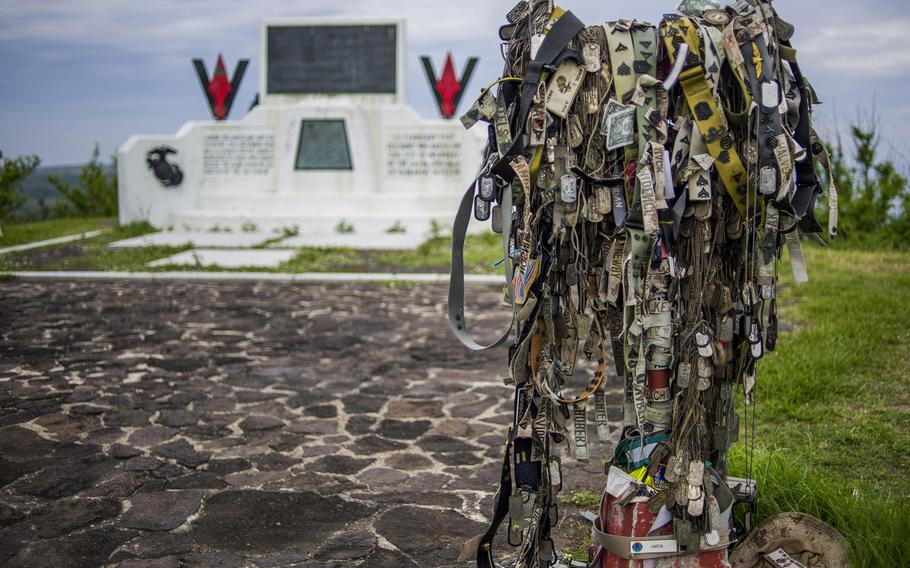
Name tape, rank and other tributes adorn the way to the monument where U.S. Marines planted the American flag atop Mount Suribachi in 1945, following the hard-fought Battle of Iwo Jima. (Courtesy of Trevor Welsh/U.S. Navy)
IWO JIMA, Japan — Japan is increasing its efforts to move critical flight training for U.S. Navy pilots off historic Iwo Jima — a relocation encouraged by military officials but opposed by residents of an island near the proposed replacement site.
At least once per year, the Navy sends its fighter aircraft from the Japanese mainland to the island, now called Iwo To, for a series of field carrier landing practice flights. The training is necessary for the pilots, who must maintain qualifications that allow them to land the Navy’s top fighter jets on aircraft carriers, such as the Japan-based USS George Washington.
The practice has gone on for decades at Iwo To, but always with a caveat: The island was meant to be only a temporary solution.
This year, Japan allocated $1 million for an environmental survey of Mageshima, an island south of Kyushu. The Japan government says it would build a runway there for Navy carrier landing practices, and use as a disaster relief hub for its self-defense forces.
In December, Japan sent a high-level Defense Ministry official to make the government’s case to residents of nearby Tanegashima island, many of whom oppose the noise they fear a new airport would bring.
From the Navy’s point of view, Mageshima is better than Iwo To due to its proximity to several other airports and Marine Corps Air Station Iwakuni — where Carrier Air Wing 5 is scheduled to move in 2017.
Iwo To’s tropical weather and isolation make it a riskier place to train than normally allowed by the Navy, said Capt. Dennis Mikeska, assistant chief of staff for operations, plans and training for Commander Naval Forces Japan.
“When the weather’s good, there’s no more realistic training … but the weather can change very quickly,” said Mikeska, who is also an F-18 pilot and graduate of the Naval Fighter Weapons School, otherwise known as TOPGUN.
He related a tale of five fighter jets attempting to land several years back, when a fast-moving cloud mass blanketed the island.
“Three landed, but there were still two aircraft in the air — and I was one of them,” he recalled.
Mikeska and another pilot were forced to emergency land on the airfield’s taxiway, he said. Then the planes couldn’t go anywhere due to near-zero visibility.
Hallowed ground, best option
Servicemembers working on the island still display respect for the place where approximately 25,000 U.S. and Japanese fighters died during World War II.
They continue to walk up Mount Suribachi, leaving their dog tags and name tape at the spot where the American flag was raised on Feb. 23, 1945. A short walk from the American monument, visitors also leave gifts at a memorial for Japanese war dead.
However, as much as sailors appreciate Iwo To’s hallowed status, they’d rather have more safety options.
No matter how poor the conditions, there isn’t any other choice for fighters but to land on the island. The closest alternate landing site is 643 miles away at Atsugi. The F-18s training at Iwo To typically don’t have enough fuel to make it back.
“They could only get about halfway before they run out of fuel,” Mikeska said.
The military could use Naval Air Facility Atsugi or another mainland base for the landing practices in case of an emergency, but it is reluctant to do so. If it did, the Navy would be forced to choose between unrealistic training and political headaches.
At Atsugi, planes fly a higher pattern to minimize noise in the densely populated communities nearby.
Even so, Atsugi is a magnet for noise complaints. On Thursday, a Yokohama court awarded $70 million to 7,054 plaintiffs seeking government compensation for noise there.
A realistic carrier landing requires a considerably lower, noisier flight pattern that those now used at Atsugi.
“Field carrier landing practice, when flown in accordance with Navy standards, is very loud,” Mikeska said.
Using Iwo To, which has no civilian residents and the right elevation for landings, removes about 150 hours of noise from the communities surrounding Atsugi.
Residents from towns on Tanegashima, near Mageshima, are well aware of the Atsugi noise complaints. Multiple local governments on the island have banded together to oppose plans for the new air field.
“The military training facility does not fit into our communities, where people have led peaceful lives by engaging in agriculture and fishing,” Mayor Chikara Nagano said, according to a spokesman.
Tanegashima communities have collected more than 220,000 signatures from throughout Japan opposing the air field since 2011, according to local officials.
However, with the move of Carrier Air Wing 5 to Iwakuni looming, Tanegashima officials say they expect the Japanese government to accelerate its efforts at Mageshima.
Stars and Stripes reporter Chiyomi Sumida contributed to this report.
slavin.erik@stripes.com Twitter: @eslavin_stripes